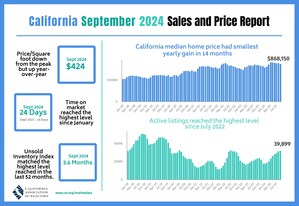Black and Latino households who can afford to buy are half that of whites, illustrating wide racial homeownership divide
- About one-fourth of all Californians could afford to purchase the $786,750 statewide median-priced home in 2021, down a couple of percentage points from 2020.
- By ethnic groups, more than one-third of white California households, and less than one in five Black and Latino California households could afford the same median-priced home, while 40 percent of Asians could buy a median-priced home.
- A minimum annual income of $144,400 was needed to make monthly payments of $3,610, including principal, interest, and taxes on a 30-year fixed-rate mortgage at a 3.16 percent interest rate.
LOS ANGELES, March 24, 2022 /PRNewswire/ -- Housing affordability deteriorated in 2021 for all California ethnic home-buying groups, largely due to double-digit home price growth that occurred during the COVID-19 crisis, the CALIFORNIA ASSOCIATION OF REALTORS® (C.A.R.) https://www.car.org/ said today.
Twenty-six percent of all Californians earned the minimum income needed to purchase a home in 2021, down from 28 percent in 2020. At the same time, housing affordability for white/non-Hispanic households fell from 38 percent in 2020 to 34 percent in 2021. Seventeen percent of Black and Latino households could afford the median-priced home in 2021, down from 19 percent and 20 percent in 2020, respectively. The significant difference in housing affordability for Black and Latino households illustrates the homeownership gap and wealth disparity for communities of color, which could worsen as rates rise further in 2022.
Housing was more affordable for Asians, with 40 percent of Asian homebuyers who could afford the median-priced home in 2021, down from 43 percent in 2020, according to C.A.R.'s Housing Affordability Index.
Multimedia:
- Motiongraphic: https://www.car.org/marketdata/data/haitraditional/haiethnicity https://car.sharefile.com/d-sc042045e452649a6b5b2707d9860aa1b
- Slides: https://car.sharefile.com/share/view/s2784b9e2115641c28fea6a434300ebdb
Despite interest rates remaining low and many employees having the flexibility to work from home, gaps in housing affordability did not improve in 2021. The housing affordability gap between Blacks and the overall population in California remained virtually unchanged at 9.2 percentage points in 2020 and 9.3 percentage points in 2021, while the gap for Hispanics/Latinos widened slightly from 8.3 percentage points in 2020 to 8.9 percentage points in 2021.
According to the Census Bureau's American Community Survey, the 2020 homeownership rate for all Californians was 56 percent, 64 percent for whites, 61 percent for Asians, 46 percent for Hispanics/Latinos and 37 percent for Blacks.
"Homeownership has an unparalleled ability to provide stability and economic security for working families and is vital to the health of our state and its citizens because it strengthens communities across California," said C.A.R. President Otto Catrina. "Promoting access to homeownership is one way to close the racial wealth gap and foster economic equity for all Californians, and that's why C.A.R. is committed to addressing ongoing fair housing and equity issues that persist in our state that have made it harder for Blacks, Latinos and other underserved communities to access and afford housing."
Last year, three C.A.R.-sponsored bills and two other fair housing bills, which C.A.R. actively supported, were signed into law by Gov. Gavin Newsom. These laws include requiring implicit bias training for real estate professionals, bills designed to address the supply and affordability challenges that disparately impact people of color and a bill to address appraisal bias.
Additionally, in an effort to address California's growing housing affordability crisis and racial homeownership divide, C.A.R. is partnering with nonprofit housing organizations to provide closing cost grants up to $10,000 for eligible first-time home buyers from an underserved community.
C.A.R.'s Housing Affordability Index (HAI) measures the percentage of households that can afford to purchase a median-priced, single-family home in California. C.A.R. also reports affordability indices for regions and select counties within the state. The index is considered the most fundamental measure of housing well-being for home buyers in the state.
A minimum annual income of $144,400 was needed to qualify for the purchase of a $786,750 statewide median-priced, existing single-family home in 2021. The monthly payment, including taxes and insurance on a 30-year, fixed-rate loan, would be $3,610, assuming a 20 percent down payment and an effective composite interest rate of 3.16 percent. The 2021 California median income for whites was $102,540, $116,060 for Asians, $71,120 for Hispanics/Latinos and $61,740 for Blacks — a more than $20,000 income gap between the overall population.
The affordability gap is especially stark in expensive counties like San Francisco, where a median-priced home of $1,825,000 was only affordable for 10 percent of Black households, 17 percent of Latino households, 24 percent of Asian households and 37 percent of white households.
Compared with California, 38 percent of the nation's Black households could afford to purchase a $353,600 median-priced home in 2021, which required a minimum annual income of $64,800 to make monthly payments of $1,620, while 58 percent of white households could afford the same home.
Key points from the 2021 Housing Affordability by Ethnicity report include:
- Of the major regions for which C.A.R. tracks affordability by ethnicity, the affordability gap between Black and the overall population in California in 2021 was the largest in Sacramento and Solano, with each registering a 13-point gap. Other counties that had a double-digit affordability gap for Black households include Alameda (-11 points), San Francisco (-11 points), San Diego (-11 points), Contra Costa (-10 points), and Fresno (-10 points). Only Riverside County was more affordable for Black households compared to all Californians.
- San Bernardino (41 percent), Riverside (37 percent), and Kern counties (37 percent) were the most affordable areas for Black households, while San Bernardino (49 percent), Fresno and Solano (both at 40 percent) were the most affordable for Hispanics/Latinos.
- For Hispanic/Latino households, the affordability gap was the biggest in Orange (-9 points), San Diego (-9 points), and Ventura counties (-9 points), while the gap was the smallest in Riverside and San Joaquin (both at -2 points) and Fresno, Sacramento and Solano counties (all at -3 points).
- At an affordability index of 10 percent, Orange and San Francisco counties were the least affordable for Black households, while San Bernardino County was the most affordable at 41 percent.
- The least affordable county in 2021 for Hispanic/Latino homebuyers was Orange, and the most affordable was San Bernardino at 49 percent.
- For white and Asian households, Orange County was the least affordable with 25 percent and 22 percent, respectively, earning the minimum income required to buy a median-price home, while Kern was the most affordable at 56 percent for whites and 65 percent for Asians.
Leading the way…® in California real estate for more than 110 years, the CALIFORNIA ASSOCIATION OF REALTORS® (www.car.org) is one of the largest state trade organizations in the United States with more than 217,000 members dedicated to the advancement of professionalism in real estate. C.A.R. is headquartered in Los Angeles.
CALIFORNIA ASSOCIATION OF REALTORS®
2021 Traditional Housing Affordability Index by Ethnicity
2021 |
C.A.R. Traditional Housing Affordability Index |
|||||||
STATE/REGION/COUNTY |
All |
White/ Non- Hispanic |
Asian |
Hispanic/ Latino |
Black |
Median Home Price |
Monthly Payment Including Taxes & Insurance |
Minimum Qualifying Income |
CA Single-family home |
26 |
34 |
40 |
17 |
17 |
$786,750 |
$3,610 |
$144,400 |
CA Condo/Townhome |
39 |
48 |
53 |
30 |
28 |
$585,000 |
$2,690 |
$107,600 |
United States |
52 |
58 |
67 |
47 |
38 |
$353,600 |
$1,620 |
$64,800 |
San Francisco Bay Area |
||||||||
Alameda |
21 |
32 |
36 |
15 |
10 |
$1,251,000 |
$5,740 |
$229,600 |
Contra Costa |
32 |
41 |
46 |
24 |
23 |
$905,000 |
$4,150 |
$166,000 |
San Francisco |
21 |
37 |
24 |
17 |
10 |
$1,825,000 |
$8,380 |
$335,200 |
San Mateo |
20 |
34 |
33 |
15 |
17 |
$2,020,000 |
$9,270 |
$370,800 |
Santa Clara |
23 |
35 |
40 |
15 |
14 |
$1,640,000 |
$7,530 |
$301,200 |
Solano |
44 |
52 |
57 |
40 |
30 |
$571,300 |
$1,966 |
$104,800 |
Southern California |
||||||||
Los Angeles |
21 |
34 |
31 |
15 |
14 |
$801,330 |
$3,680 |
$147,200 |
Orange |
19 |
25 |
22 |
10 |
10 |
$1,099,000 |
$5,040 |
$201,600 |
Riverside |
34 |
44 |
49 |
33 |
37 |
$560,000 |
$2,570 |
$102,800 |
San Bernardino |
45 |
52 |
58 |
49 |
41 |
$425,000 |
$1,950 |
$78,000 |
San Diego |
24 |
32 |
34 |
15 |
13 |
$830,000 |
$3,810 |
$152,400 |
Ventura |
25 |
33 |
42 |
16 |
25 |
$825,000 |
$3,790 |
$151,600 |
Central Valley |
||||||||
Fresno |
43 |
55 |
50 |
40 |
33 |
$369,960 |
$1,700 |
$68,000 |
Kern |
46 |
56 |
65 |
38 |
37 |
$324,450 |
$1,490 |
$59,600 |
Sacramento |
41 |
49 |
51 |
38 |
28 |
$500,000 |
$2,300 |
$92,000 |
San Joaquin |
39 |
51 |
56 |
37 |
35 |
$420,000 |
$1,950 |
$78,000 |
SOURCE CALIFORNIA ASSOCIATION OF REALTORS® (C.A.R.)

WANT YOUR COMPANY'S NEWS FEATURED ON PRNEWSWIRE.COM?
Newsrooms &
Influencers
Digital Media
Outlets
Journalists
Opted In






Share this article